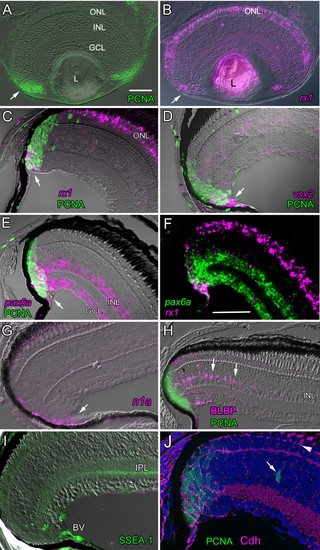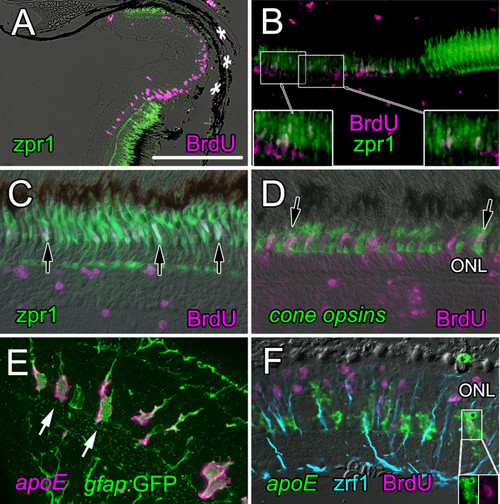- Title
-
Molecular characterization of retinal stem cells and their niches in adult zebrafish
- Authors
- Raymond, P.A., Barthel, L.K., Bernardos, R.L., and Perkowski, J.J.
- Source
- Full text @ BMC Dev. Biol.
|
Molecular characterization of postembryonic neurogenesis in the CMZ of the zebrafish retina. A) and B) Larval zebrafish (4 dpf). A) Mitotic retinal progenitor cells in the CMZ (arrow) immunoreactive for PCNA (green). B) rx1 (magenta) in the CMZ (arrow) and in differentiated cones in the outer nuclear layer (ONL). L, lens; GCL, ganglion cell layer, INL, inner nuclear layer. Scale bar = 50 μm. C) – J) Two-month-old juvenile zebrafish retinas. C) Cells in peripheral CMZ are double-labeled (white arrow) with rx1 (magenta) and PCNA (green). D) Cells in peripheral CMZ are double-labeled (white arrow) with vsx2 (magenta) and PCNA (green). E) Amacrine cells in the INL and ganglion cells in the GCL express pax6a, and many PCNA+ cells in the CMZ are double-labeled with pax6a (white arrow). F) Cells in the peripheral CMZ co-express rx1 (magenta) and pax6a (green). Scale bar = 50 μm. G) Cells in the CMZ (arrow) express notch1a (magenta). H) PCNA+ cells (green) in the CMZ, nonpigmented cells in the adjacent ciliary margin and Müller glia (arrows) in the differentiated retina adjacent to the CMZ are BLBP+. BLBP-immunoreactivity gradually disappears from Müller glia more centrally. I) Immunoreactivity for SSEA-1/LeX (green) around the circumferential blood vessel (BV) and in a narrow band of the inner plexiform layer, IPL. J) Immunoreactivity for N-cadherin protein (Cdh, magenta) completely surrounds the cell bodies of PNCA+ (green) mitotic cells in the CMZ and cells in the adjacent non-pigmented ciliary epithelium. In the laminated retina, N-cadherin is localized to the zonula adherens junctions of the outer limiting membrane (arrowhead) and synaptic layers. An isolated PCNA+ cell in the inner nuclear layer (arrow) is an INL progenitor in the rod lineage. Nuclei are counterstained with DAPI (blue). EXPRESSION / LABELING:
|
|
Injury-induced proliferating retinal progenitors express rx1, vsx2, and pax6a. A) – D) Histology of the heat-lesioned retina at 1 and 3 dpl; the boxed area in A) is magnified in B). Cell loss is mainly confined to the retinal pigmented epithelium (RPE) and photoreceptors in the outer nuclear layer, ONL. The CMZ (arrow in A) is at the junction between the neural retina and the ciliary epithelium (CE), which is continuous anteriorly with the iris epithelium (IE). Scale bar (A) = 150 μm. C) At 3 dpl double cones immunoreactive with zpr1 (red) are missing from the lesioned area and elongated nuclei appear in the inner nuclear layer (white arrows). Counterstained with DAPI (blue). D) By 3 dpl, radial fibers of Müller glia in the inner nuclear layer, INL, are visible in the region of the lesion (black arrows), indicative of reactive gliosis. Scale bar = 50 μm. D) Proliferating cells in the inner and outer nuclear layers of the retina in the lesioned area (asterisks) at 5 dpl incorporated BrdU (green) injected at 4 dpl. E) Injury-induced proliferating cells are also immunoreactive for proliferating cell nuclear antigen, PCNA (green) and are associated with radial fibers of Müller glia (magenta, anti-human GFAP). Note: the commercial polyclonal GFAP antibody used here is not selective for GFAP in zebrafish but labels other intermediate filaments (data not shown). In contrast, the monoclonal zrf1, which was generated against zebrafish proteins, selectively labels zebrafish GFAP [97]. Scale bar = 50 μm. F) – L) A 4 h or 24 h pulse of BrdU at 4 or 5 dpl labels clusters of nuclei (magenta) that extend between the INL and ONL and express rx1 (F) and vsx2 (J) as visualized by in situ hybridization (red). DAPI (blue); zrf1 (green, anti-zebrafish GFAP). Scale bar = 25 μm. Higher magnification views of rx1 (G,H, I) and vsx2 (K, L) in BrdU+ progenitors enclosed in a basket of zrf1+ Müller glial fibers. EXPRESSION / LABELING:
|
|
Molecular profile of the injury-induced proliferating retinal progenitors is similar to retinal stem cells in the CMZ. A) At 4 dpl deltaC expression (dlc; magenta) is upregulated in the CMZ (arrow) and in cells in the INL beneath the lesion (asterisks). Scale bar = 150 μm. B) At 4 dpl, cells in the CMZ (arrow) and lesioned area labeled with a 2-hour pulse of BrdU (green) also express deltaC (magenta). C) notch1b (n1b; green) and D) notch3 (n3; green) are also up-regulated but are generally not co-expressed with deltaC (magenta). E) At 4 dpl, N-cadherin immunoreactivity (Cdh2; magenta) is strongly up-regulated in the lesioned area (asterisks) and diffusely localized. Inset: zrf1, anti-zebrafish-GFAP (green) in radial fibers of Müller glia in the lesioned retina (7 dpl) co-localizes with N-cadherin immunoreactivity (magenta). F) At 7 dpl, BrdU+ nuclei (green) associate with Müller glial radial fibers that are strongly immunoreactive for N-cadherin (magenta). DAPI (blue). G) At 3 dpl, activated Müller glia confined to the lesioned region (asterisks) express BLBP (magenta), a marker of immature Müller glia, and they are mitotically active (PCNA+, green). H) Radial fibers of injury-activated Müller glia are zrf1+ (blue). Proliferating Müller nuclei are PCNA+ (green) and many have migrated to the apical surface (the former ONL where photoreceptors are missing) and are BLBP+ (magenta). EXPRESSION / LABELING:
|
|
Injury-induced retinal progenitors regenerate cone photoreceptors within a week. A) At 4 dpl, proliferating cells (BrdU; magenta) fill the lesioned area (asterisks) in which double cones immunoreactive for zpr1 (green) are missing. Scale bar = 250 μm. B) By 7 dpl, some retinal progenitors that were labeled with BrdU (magenta) at 4 dpl have begun to differentiate into cones and are double-labeled with zpr1 (green). Boxed areas are shown at higher magnification in the insets; double-labeled cells are white. C) By 31 dpl fully differentiated, regenerated cone photoreceptors (zpr1; green) are labeled with BrdU (magenta) injected at 3 dpl (double-labeled white nuclei are indicated by black arrows). Unidentified BrdU+ nuclei are seen in the inner retina. D) Cocktail of riboprobes to cone opsins (green) identifies BrdU+ (magenta), regenerated cones at 31 dpl (double-labeled white nuclei are indicated by black arrows). BrdU+ rod nuclei (magenta) are in the inner part of the outer nuclear layer, ONL. E) Müller glia in a transgenic zebrafish Tg(gfap:GFP)mi2001 are labeled with anti-GFP (green) and co-express apoE (magenta, in situ hybridization) in their cell bodies. F) At 4 dpl, most BrdU+ proliferating nuclei are in the outer nuclear layer, ONL, but a few apoE+ Müller glial cells are also BrdU+ (inset). Radial fibers of Müller glia are labeled with zpr1/anti-GFAP (blue). EXPRESSION / LABELING:
|

Table 1 EXPRESSION / LABELING:
|




